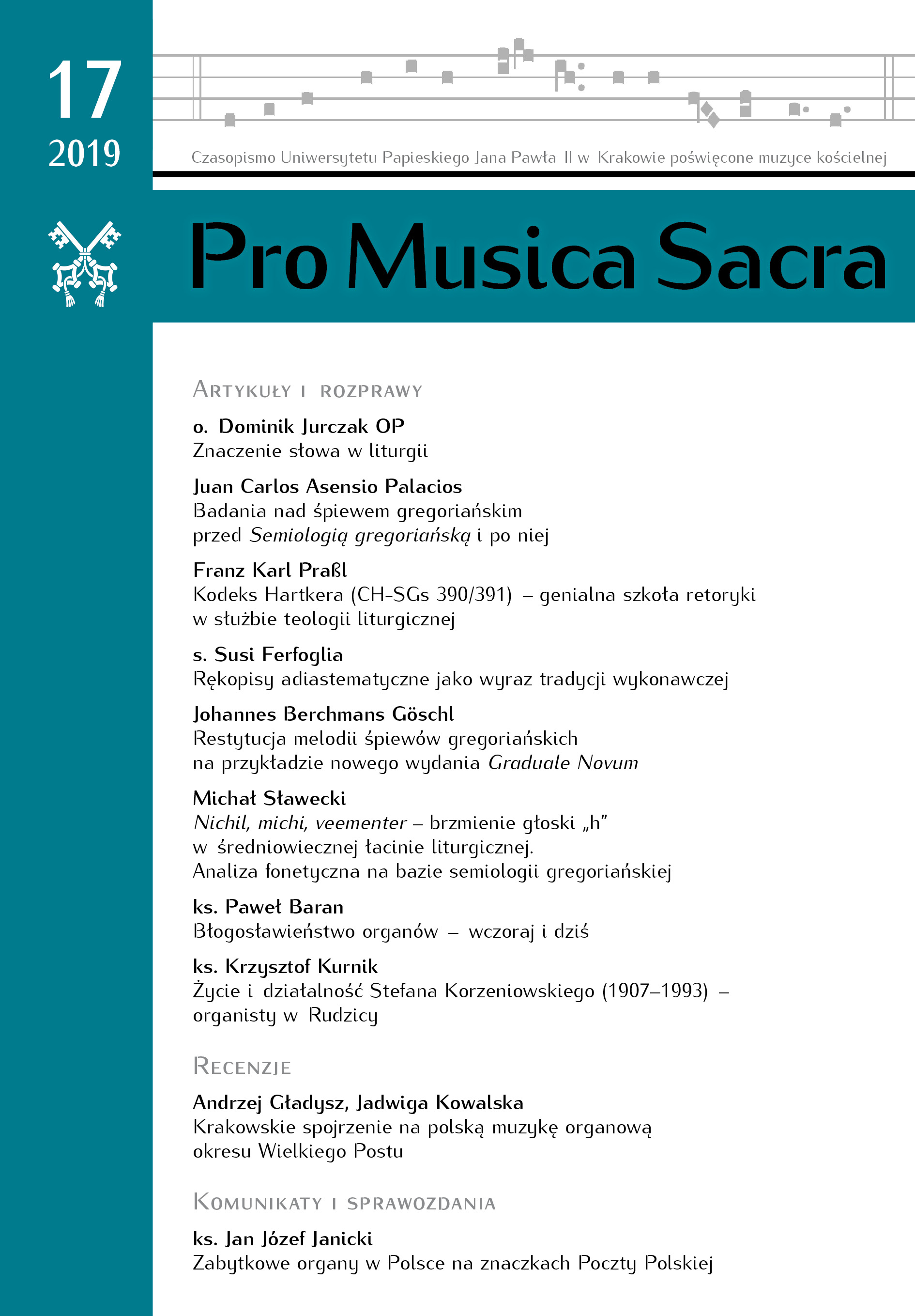The manuscript „Hartker“ (CH-SGs 390/391 – a brilliant instruction of rhetorics serving for liturgical theology
DOI:
https://doi.org/10.15633/pms.3491Keywords:
cantillation, music interpretation of biblical texts, St. Gallen, rhetorics, Hartker, antiphoner, liturgical theology, aggiornamentoAbstract
Liturgical music in the first millennium was first of all cantillation, reciting liturgical texts with musical formulae and phrases to express structure and meanings of a text. With the means of spoken language a cantor had to give all informations of reading or prayer. Two elements are basic for a good recitation: Accent and articulation. All the types of cadences are acoustic punctuation marks. The oldest neumes had to serve for these rules of language. The monk Hartker was according to the tradition the scribe of a prominent antiphoner about the year 1000. In reality this manuscript had four main scribes and a lot of additional hands. All of them have followed the principle of expressing liturgical theology by means of music like accent and articulation. The examples presented show, how the scribes have understood the texts, which words in an antiphon served as key words, which theological aspects were important for them. This is a school of prayer according to the principle of logiké latreia, praying with intellect and spirit and emotion. Hartker is the aggiornamento of the bible in the 10th century.References
Abbatia Sanctae Mariae de Pratalea, Liber Antiphonarius pro diurnis horis Liturgiae horarum monasticae schema B, t. 1, De Tempore, Teolo 2017.
Agustoni L., Göschl J. B., Einführung in die Interpretation des Gregorianischen Chorals, t. 1, Regensburg 1987, s. 97–134.
Angenendt A., Geschichte der Religiosität im Mittelalter, Darmstadt 1997.
Antiphonae et Responsoria pro diurnis horis restituta et ornata neumis Sangallensibus praesertim
Antiphonarii 390–391, quod dicitur, Hartkerii. (Liturgia Horarum secundum Ordinem
Cantus Officii anno MMXV a Sacra Congregatione de Cultu Divino et Disciplina
Sacramentorum editum), t. 1, Tempus Adventus et Nativitatis, t. 2, Tempus Quadragesimae,
Sacrum Triduum Paschale, Tempus Paschale, Verona 2016–2017.
Antiphonale Monasticum [= Liber Antiphonarius pro diurnis Horis], t. 1–3, Solesmes
–2007.
Boethius, De institutione arithmetica libri duo, De institutione musica libri quinque, ed.
G. Friedlein, Leipzig 1867.
Cantor and Cantorial music. The New Encyclopedia of Judaism, ed. G. Wigoder, F. Skolnik,
S. Himelstein, New York 2002.
Dobszay L., Tätigkeitsbereich und Ausbildung – historische Modelle des Kirchenmusikerberufes,
„Singende Kirche” 54 (2007), s. 14–18.
Franz A., Die Tagzeitenliturgie der Mailänder Kirche im 4. Jahrhundert. Ein Beitrag zur
Geschichte des Kathedraloffiziums im Westen, „ALw” 34 (1992), s. 23–83.
Graduale Novum, editio magis critica iuxta SC 117, t. 1, De Dominicis et Festis, t. 2. De
Feriis et Sanctis, Regensburg 2011–2018.
Hiley D., Western Plainchant. A Handbook, Oxford 1993, s. 46–68, www.epub.uni-regensburg.
de/25558/1/ubr12760_ocr.pdf (20.11.2018).
Kurzschenkel W., Die theologische Bestimmung der Musik, Trier 1971.
Medieval Cantors and Their Craft. Music, Liturgy and the Shaping of History, ed. K. A.-M.
Bugyis, A. B. Kraebel, Margot Fassler, York 2017, s. 800–1500.
Pouderoijen K., de Loos I., Wer ist Hartker? Die Entstehung des Hartkerischen Antiphonars,
„BzG” 47(2007), s. 67–86.
Praßl F. K., Muss Hartker Vergleiche fürchten? Zur Notation einer Sammelhandschrift des 10.
Jh. aus St. Alban, Mainz, heute Wien ÖNB codex latinus 1888, „BzG 59/60” (2015),
s. 203–219.
Praßl F. K., Scriptor Interpres. Von Neumenschreibern und ihren Eigenheiten „BzG” 37 (2004),
s. 55–72, 60–61.
Rankin S., Vor Sankt Gallen: Klänge einfangen – Notationen gestalten – Musik aufschreiben
zwischen 800 und 900, BzG 65/66 (2018), s. 47–68, 64n.
Schmid B., Deutscher Liturgiegesang, w: Musik im Gottesdienst, ed. H. Musch, t. 1, Regensburg
, s. 357–520, 403.
Totzke I., Dir singen wir. Beiträge zur Musik der Ostkirche, St. Ottilien 1992.
Źródła internetowe
www.e-codices.unifr.ch/de/list/csg/Shelfmark (30.11.2018).
Downloads
Published
Issue
Section
License
Authors who publish with this journal agree to the following terms:
- Authors retain the copyright and full publishing rights without restrictions, and grant the journal right of first publication with the work simultaneously licensed under a Creative Commons Attribution 4.0 International License that allows others to share the work with an acknowledgement of the work's authorship and initial publication in this journal.
- Authors are able to enter into separate, additional contractual arrangements for the non-exclusive distribution of the journal's published version of the work (e.g., post it to an institutional repository or publish it in a book), with an acknowledgement of its initial publication in this journal.
- Authors are permitted and encouraged to post their work online (e.g., in institutional repositories or on their website) prior to and during the submission process, as it can lead to productive exchanges, as well as earlier and greater citation of published work (See The Effect of Open Access).

